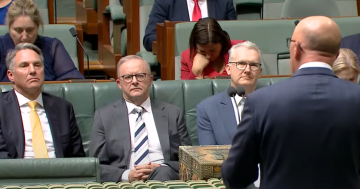Ludmila Leiva* proposes a simple but effective budgeting method that doesn’t involve tracking every penny.
 Budgets are rubbish. The idea of tracking and regimenting your spending can seem overwhelmingly tedious, and it certainly can be.
Budgets are rubbish. The idea of tracking and regimenting your spending can seem overwhelmingly tedious, and it certainly can be.
Plus, at a time when money anxiety is on the up, reckoning with complicated budgets can feel like opening a can of worms.
But not all budgets are created equal.
If you’re looking to get your money in order, one of the easiest, most effective ways to organise your finances is by using the 50/30/20 rule.
Senator Elizabeth Warren created the 50/30/20/rule for spending and saving when co-authoring a personal finance book with her daughter, Amelia Warren Tyagi: All Your Worth: The Ultimate Lifetime Money Plan.
The rule is a simple, accessible way to understanding how to best spend your cash.
By organising your expenses into three main spending categories, the 50/30/20 rule is a surefire way to getting your spending under control while helping you get closer to reaching your financial goals — all without having to stress over money minutiae.
Read on to learn the simple four steps you need to get started using the 50/30/20 rule in your own life.
Figure out your after-tax income
If you’re on a salary, it’s easy to think of your pre-tax income as your actual income.
But this isn’t the case.
Taxes eat up a considerable chunk of a salary.
After all the deductions have been taken out, your take-home pay is quite different from the amount you were offered when you got your job.
For this reason, it’s important to get a better understanding of what you’re actually making before you start thinking about how to spend it.
To figure out your actual take-home income, try just, you know, taking a look at your paycheque.
There should be an in-depth breakdown of what’s getting withheld from each check as well as a final number that indicates your gross pay.
If you’re a freelancer, or someone without a fixed income, this can be even trickier to manage.
A good rule of thumb is to build a financial plan around your average gross income — after accounting for expenses and taxes: Look back at your invoices for the past three or six months, and then average your monthly income to get an idea of what you usually make.
If you’re up for the challenge, you can also project your income each month and plan based on that number.
Limit your “needs” to 50 per cent
Now that you’ve figured out your monthly after-tax income, take a minute to think about your monthly financial responsibilities.
According to the 50/30/20 rule, your essentials, or “needs” — things like rent, utilities, health insurance, groceries, and transport — should only add up to a maximum of 50 per cent of your take-home pay.
Don’t get too philosophical about what your true “needs” are.
For this category, just consider things you can’t live without.
For instance, if you don’t pay your rent you’ll probably run into some troubles, so that would count as a need.
You also need to eat, it’s likely you need transport to get to work, and you probably can’t live without heat and electricity.
Limit your “wants” to 30 per cent
The 30 in the middle means 30 per cent of your income should go to flexible spending, or “wants.”
Sure, 30 per cent might sound like a pretty generous chunk.
But when it comes down to it, it’s not that much.
But, remember, wants don’t just mean things like trips to Mexico and that new pair of Nikes.
They account for all of the other things that fall outside of your immediate needs, so count expenses like your phone bill, your Netflix account, and the takeaway you just ordered on Uber Eats.
Also, if you have credit card debt, you should include any monthly minimum payments in your “wants” category.
With those expenses in mind, 30 per cent might not end up feeling like very much.
Beyond the things you actually need — say a basic wardrobe that will keep you warm and dry in all seasons — that extra beret or pair of winter boots don’t count as needs.
When I think back, there have been a lot of months where my “wants” have accounted for a lot more than just 30 per cent of my income, and I know I’m not alone.
Thinking about your needs is a great opportunity to reflect on the expenses in your life and what you’re spending on versus what you should actually be spending.
Save the last 20 per cent
Once you’ve accounted for the first 80 per cent of your income — with 50 per cent going to needs and 30 per cent to wants — you’re left with 20 per cent.
This last portion should be reserved for savings and additional debt repayments, depending on your circumstances.
First, you’ll want to focus on saving money in an emergency fund, then put money towards a house down payment and paying off debt (including student loans, balance transfers, or car loans).
Do you have all of those things under control? Well then you can start saving this money toward other future goals like buying a home, starting a business, or kids!
This percentage may seem small compared to the others, but if you’re using it wisely, then this 20 per cent can add up quickly.
And remember, if you’re able to cut down on your wants category, you can always save more than the 20 per cent minimum set out by this plan.
How it works & why
Now that you know the basics, it’s time to figure out how well you’re doing.
First, calculate your after-tax income.
Then break it down into the 50/30/20 buckets.
From there, spend a month keeping track of how much you spend and make sure you don’t exceed your limits.
If you find you’re overspending, it’s probably time to reassess.
The 50/30/20 rule is simple and straightforward, without any unnecessary complications.
If you use it correctly, it allows you to pay all of your bills, grow your savings, and still have money to spend on the fun stuff, which is so important.
Choosing a financial plan that works isn’t just about saving money, it’s about prioritising and organising your spending so that you can still enjoy the life you’re living.
And, the great thing is that it’s flexible; if these exact percentages aren’t working for you, you can always tweak them.
After all, it’s no fun to just save for retirement while spending the present stressing about daily expenditures and the occasional indulgence.
*Ludmila Leiva is a contributor at Refinery29.
This article first appeared at refinery29.com.











